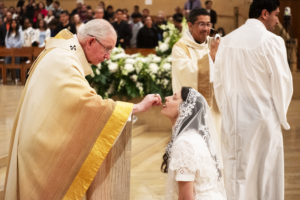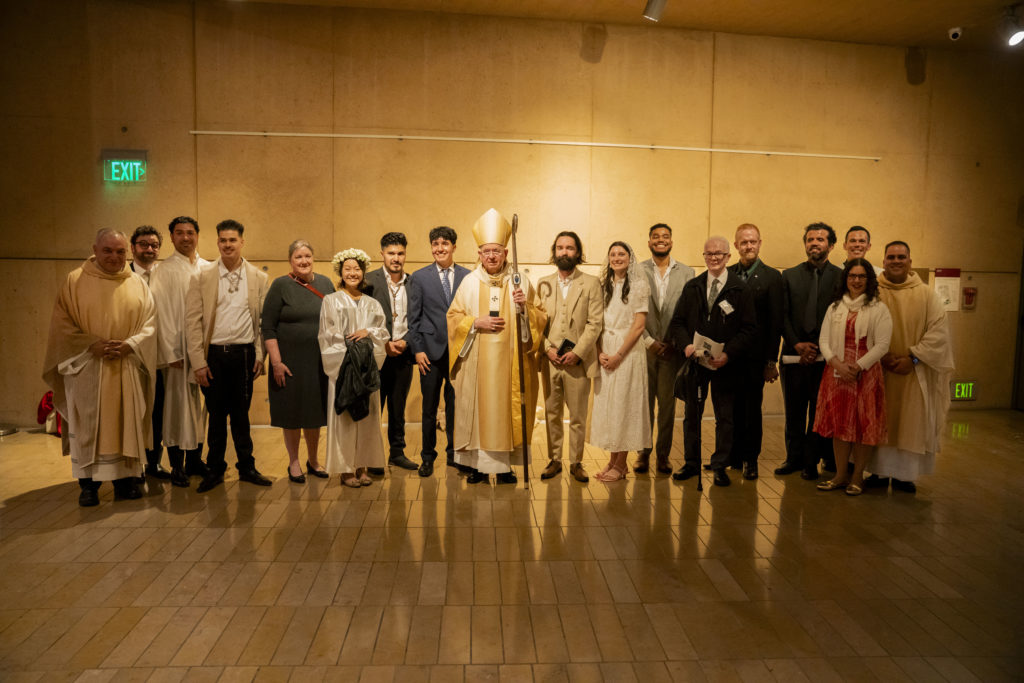At the Easter Vigil last month in the Cathedral of Our Lady of the Angels, 66-year-old Michael Cardona was received into the Catholic Church after a spiritual journey that included two Protestant baptisms and 30 years as a Hindu guru.
“I was lost,” said Cardona, who identifies with the prodigal son. He had significant health problems and sensed the Holy Spirit urging him not to delay.
“I had to make sure that I at least got the Eucharist one time before I die,” he said.
He joined a surge of adults who entered the Church nationwide this Easter. Baptisms of adults, older children, and teens hit an all-time high in the Archdiocese of Los Angeles with 2,075 — an increase of 38% over the 2016 record. Cardona was among 1,521 candidates received after baptism in other Christian traditions, bringing the total to 3,696.
National numbers are unavailable, but many individual dioceses reported dramatic increases. The Archdiocese of Baltimore rose more than a third to 663. The 2,364 converts in the Archdiocese of Galveston-Houston marked the first total above 2,000 since 2019. Increases were not confined to large, urban archdioceses. The Diocese of Yakima in the high desert of central Washington reported the most converts in its 73-year history, with 460.
Social scientists attribute the increase to pent-up demand after COVID-19.
Mark Gray crunches sacramental statistics as the senior research associate at the Center for Applied Research in the Apostolate (CARA). Pointing to indications that Sunday Mass attendance is back to pre-COVID levels, he believes increased conversions reflect that rebound.
During COVID, “a lot of parishes were unable to have Mass and to celebrate the sacraments. There are people who would have entered the Church at that time, but couldn’t,” he said.
Engagement to a Catholic is the most common reason people enter RCIA (Rite of Christian Initiation of Adults), he said.
“So not only did you probably have a delay in those marriages, but it also delayed people being able to go through RCIA.”

Marilyn Santos, associate director of the Secretariat of Evangelization and Catechesis at the U.S. Conference of Catholic Bishops, believes that post-COVID catch-up is just one part of the story.
She hears increasing reports of whole families participating in the RCIA (which the U.S. bishops now refer to with a slightly changed translation: the OCIA, or “Order of Christian Initiation of Adults.” While most converts enter the Church at the Easter Vigil, this new structure acknowledges that converts could be baptized or welcomed into the Church at any point in the year, even taking multiple years before making the final decision. Practically speaking, parishes will be adjusting to this new term over the next few years, phasing out the term RCIA and switching over to the use of the term OCIA.)
Perhaps, she said, part of COVID’s impact was to show the value of family, faith, and community. She also wonders if the explosion of devotion to Blessed Carlo Acutis during the National Eucharistic Revival has played a part, since he led his own parents into the Church.
“We have heard some incredible stories during the National Eucharistic Revival of people who have experienced total conversion because of the revival,” she said.
Regardless of why non-Catholics are attracted to the Church, “kindness and hospitality mean a lot,” she said. “If you do something as simple as being welcoming, the rest will come.”
Just before COVID struck, the Archdiocese of Los Angeles had committed to upgrading its adult initiation process with better training for parish leaders. Leticia Perez, now archdiocesan coordinator for Christian initiation, began full-time assistance to parish initiation ministries after years of juggling it with other duties.
During COVID, it was impossible to do RCIA online because it required liturgical gatherings. However, the sudden shift to virtual meetings allowed the archdiocese to immediately involve RCIA leaders from every parish in its extensive new training. Participants emerged from COVID far more prepared to lead the initiation of adults, Perez said.
She believes that’s a key to the record baptisms and receptions in the LA Archdiocese.
Unlike when she was a parish RCIA leader years ago, “we have a lot of resources. They can call me and ask questions. If I don’t know the answer, I can find out.”
A new trend she has recently become aware of is for some parents to delay their children’s baptism for years, so they receive all three sacraments through RCIA at age 7 or 8.
She suspects that some parents think it will be too difficult to prepare adolescents for confirmation.
“I think parents (are concerned) that they cannot control teenagers to bring them to the Church,” Perez said. “That is one of the realities. Another is work, another is convenience. Or you can have a situation of divorce, where the child isn’t baptized, or they were raised in another denomination. So, there are many different reasons.”
Regardless of why more people became Catholic this year, it’s a sign that God is at work, said Santos at the U.S. bishops’ conference.
“The message is that, in spite of the hard times — that are sometimes by our own fault — God is bigger,” she said.

